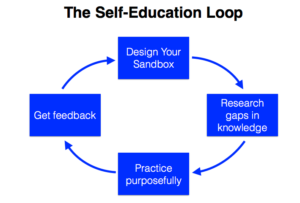“It is better to know how to learn than to know.” – Dr. Seuss
At no point in history were you more capable of teaching yourself anything than today.
Picking up new skills has become as easy as firing up Google, doing some research, practicing in the right ways, and pushing yourself through the plateaus.

It’s no longer necessary to get a college degree to be qualified to do something, and while big, old companies haven’t realized that yet, it’s common wisdom in smaller, more forward-thinking startups. Plenty of successful people today got where they are today by teaching themselves the skills, and there’s no reason you can’t do the same.
How We Learn
There are no classes where the professor shows up and says “figure out how to build a website by tomorrow,” and then leaves. It’s more likely that you’ll be taught one way to build a website (probably using some awful tool like Dreamweaver) and then expected to follow the steps you were shown.
But that’s not how learning works in the real world. If you want to do anything remotely independent (entrepreneurship, creative work, freelancing, writing, lifestyle businesses, etc.) then you have to be able to figure things out without being handed the knowledge beforehand.
The way we’re taught to learn:

The way you really learn:

The Sandbox Method for Self-Education

The sandbox method is an ongoing process for self-education, based on the latest scientific research on how we learn and how we process information.
Step 1: Build Your Sandbox
Before doing any research on how to do, or how to better do, what you want to learn, you need to create an environment to practice it in.
This sandbox should be:
- Low cost or free: so you don’t delay in starting
- Low-stakes: so you’re not afraid to fail or show your work
- Public: so that you have to put your work out there in some manner
Some examples:
- Programming: Accounts on Github, Heroku, and StackExchange for building projects and asking for help.
- Writing: A personal blog hosted on WordPress, Medium, or SquareSpace.
- Photography: Your camera and Instagram account.
- Design: Sketch, and a Dribbble account to show your work on.
- Marketing: A blog or information site hosted on WordPress that you can try to grow.

Step 2: Research

To continue expanding the borders of your sandbox, the extent of the skill that you can practice and apply, you’ll need to do a certain amount of research. The resources exist online to teach yourself anything, you just have to figure out what’s worth reading, watching, or listening to.
Step 3: Implement and Practice
Within your sandbox, how you practice what you’re learning will be as important as what you choose to practice. The wrong practice methods can lead to hours, days, even years of wasted repetition, but the right practice methods can accelerate you to the level of competency in a matter of months.

Step 4: Get Feedback
As you practice deliberately within your sandbox, continuing to do research to fill in the gaps of your knowledge, the last (and necessary) piece of the self-education process is getting feedback.
Continue the Self-Education Loop
Once you’ve gone through the process of designing your sandbox, researching how to improve your skill, applying that knowledge to purposeful practice within your sandbox, and getting feedback on your work as you’re going, you simply repeat the process to continue developing your skill.

Troubleshooting
Finally, it’s possible that you’ll eventually get stuck somewhere. When that happens, you have to assess what the problem might be.
